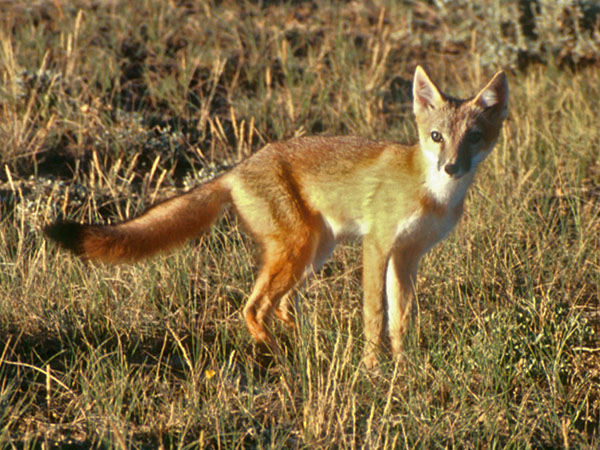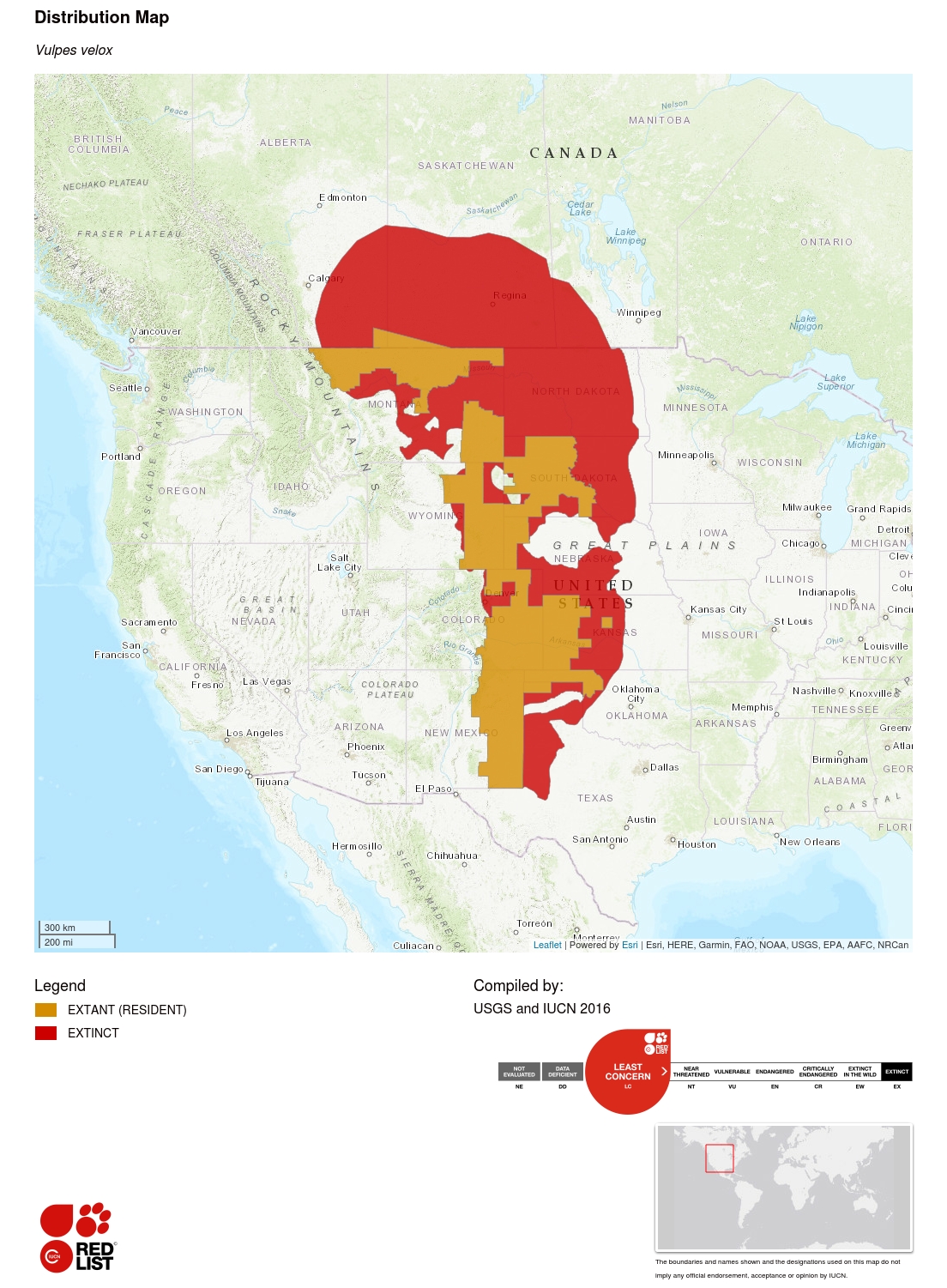
- South America
- Central & North America
- Europe & North/Central Asia
- Sub-Saharan Africa
- North Africa & the Middle East
- South Asia
Central & North AmericaSwift fox Vulpes velox

swift fox - © Travis Olson
Island, Kit & Swift Fox Working Group - Brian Cypher and Donelle Schwalm are the coordinators of the Island, Kit & Swift Fox Working Group. The working group report that for both kit foxes and swift foxes, habitat continues to be lost and remaining habitat is increasing subject to degradation, fragmentation, and incompatible uses. The future prognosis for island foxes is however significantly improved. After 4 of 6 subspecies suffered catastrophic declines due to novel predators and disease, mitigation measures have been immensely successful and these 4 populations have returned to or are approaching pre-decline levels. This page highlights some of the recent issues and current conservation needs for these species.
ProjectsRelevant Links- Flickr: Wild Canids of the World
- 2016 IUCN Red List Assessment - Swift Fox
- Kit Fox & Swift Fox Bibliography
- Cochrane Ecological Institute's Swift Fox Reintroduction Program
English: Swift Fox
French: Renard Véloce
German: Flinkfuchs

Justification
The Swift Fox was extirpated from Canada by 1938. By the early 1900s in the United States, the Swift Fox was also considered extirpated from Montana, North Dakota, Nebraska, Kansas, and Oklahoma with severe population reductions in other range states. The historic range of the Swift Fox is estimated to have been approximately 1.5 million km². Swift Fox populations began to recover gradually as of the 1950s in the central portions of their range. Reintroductions have been attempted in Alberta/Saskatchewan, Canada, resulting in restorations to approximately 3% of the national historic range. Subsequently, dispersal from Canada and reintroductions in Montana have created a contiguous Canada/Montana population. Reintroductions have also helped to re-establish populations in South Dakota. As of 2009, Swift Foxes exist in 44% of their historic range in the United States. Approximately 52% of highest quality habitats in the United States are currently occupied; suggesting further recovery is possible if potential threats are mitigated. The current population does not meet any of the thresholds for the threatened categories, therefore the species is presently assessed as Least Concern.
Geographic Range Information
The Swift Fox is native to shortgrass and mixed-grass prairies of the Great Plains in North America (Egoscue 1979). On the northern limit of its range, the Swift Fox was present in the Canadian provinces of Alberta, Saskatchewan, and Manitoba. The southern species boundary was New Mexico and Texas in the United States. A fossil record exists for eastern Missouri. Historical records also exist for areas in Montana, Wyoming, North Dakota, South Dakota, Nebraska, Kansas, Colorado, and Oklahoma. Some historical range descriptions include Swift foxes in Minnesota and Iowa; however, there are no verified records of occurrence in either state (Sovada and Scheick 1999). Iowa has one fossil record and several unconfirmed accounts. One Swift Fox has also been documented in Minnesota recently (Sovada et al. 2009).
Population trend:Stable

Population Information
Historically, the Swift Fox was considered an abundant predator of the prairies, but numbers were severely depleted by the late 1880s and early 1900s. In Canada, the last recorded specimen was collected in 1928 (Carbyn 1998) and a single sighting was made in 1938 (Soper 1964). Zumbaugh and Choate (1985) provided evidence that, in Kansas, Swift Foxes were abundant in the mid-1800s, but became less abundant by the turn of the 20th century. The species was probably extirpated from Kansas by the 1940s (Black 1937, Cockrum 1952, Hall 1955, Sovada and Scheick 1999). By the early 1900s in the United States, the Swift Fox was also considered extirpated from Montana, North Dakota, Nebraska, and Oklahoma with severe population reductions in other range states (Sovada et al. 2009).
Swift Fox populations began to recover over portions of their former range beginning in the 1950s (Martin and Sternberg 1955, Glass 1956, Anderson and Nelson 1958, Andersen and Fleharty 1964, Kilgore 1969, Sharps 1977, Egoscue 1979, Hines 1980, Sovada et al. 2009). In the core of their distribution, in Kansas, Colorado and the Oklahoma panhandle, and New Mexico, populations are considered stable (Allardyce and Sovada 2003, Sovada et al. 2009). Populations in Wyoming, Texas, and Nebraska are more fragmented but generally stable (Sovada et al. 2009). Swift Foxes are beginning to re-occupy western North Dakota; occasional sightings have been recorded every year since 2005 and in 2013 the first den in recent years was documented (North Dakota Game and Fish, S. Tucker, ND Game and Fish Department, pers. comm. 2016). In addition, in 2007 a in single Swift Fox was documented in western Minnesota (Sovada et al. 2009). The historic range of the Swift Fox is estimated to have been approximately 1.5 million km². By 2009, Swift Foxes existed in 3% of their historic range in Canada and 44% of their historic range in the United States.
Following approximately 50 years of extirpation, a Swift Fox reintroduction programme was initiated in Canada in 1983. By 1997, 942 foxes obtained primarily from captive breeding but also through translocation had been released in Southern Alberta and Saskatchewan (Moehrenschlager and Macdonald 2003). Using live trapping, a 1996/1997 population survey established the Canadian population to consist of two isolated subpopulations. A second population survey that re-sampled these sites during the same season in 2000/2001 also expanded the survey area into Montana (Moehrenschlager and Moehrenschlager 2001, Moehrenschlager et al. 2004). The results suggested that Swift Fox population size in Canada had increased approximately three-fold since 1996/1997, the total known distribution including Montana spanned at least 17,500 km², and that 99% of the population was wild-born. A third survey in 2005-2006 suggested the population had remained stable within Canada, 100% of 196 trapped individuals were wild-born, and ranges in Montana had expanded slightly to a combined population extent of occurrence of 21,954 km² (Moehrenschlager and Moehrenschlager 2006). Genetic assessments corroborate growth in effective population sizes, suggested healthy heterozygosity, indicated stability in genetic diversity over time, and illustrated significant population structure differences between eastern and western regions of the reintroduced population (Cullingham and Moehrenschlager 2013). A fourth 2013-2015 range-wide assessment has been completed recently (Moehrenschlager, unpubl. data), and a preliminary analysis may suggest a population constriction. This population is considerably isolated from the contiguous Swift Fox range in the United States and needs to be considered separately in terms of population viability.
Reintroduction successes in Canada sparked additional reintroductions in the United States. Releases in north-eastern Montana of 123 foxes from 1998-2002 inclusive, were able to establish a growing population of over 100 foxes by 2005 (Ausband and Foresman 2007a,b) that is generally isolated from the Canadian population although one dispersal event has been documented between the populations (Ausband and Moehrenschlager 2009). Short-term reintroductions have been attempted at Fort Peck Tribal Lands, Montana and Lower Brule Sioux Tribal Lands, South Dakota with more limited success. In South Dakota, successful reintroductions have been attempted at three sites. At Bad River Ranch, 179 Swift Foxes were released from 2002 to 2007 with a variety of soft and hard release techniques yielding successful survival, reproduction, expansion, and some long-distance dispersal (Sasmal et al. 2015). At least two male Swift Foxes from this site came in contact with a separate reintroduced population at Badlands National Park/Buffalo Gap National Grassland, producing at least one litter (Sovada et al. 2009). This population, which involved the release of 400 Swift Foxes has not only shown good demographic growth but also high genetic diversity (Sasmal et al. 2013).
Habitat and Ecology Information
The Swift Fox is predominately found on short-grass and mixed-grass prairies in gently rolling or level terrain (Kilgore 1969, Hillman and Sharps 1978, Hines 1980, Gese and Thompson 2014). In Kansas, Swift Foxes have been found to den and forage in fallow cropland fields such as wheat (Jackson and Choate 2000, Sovada et al. 2003). Survival rates (and reproductive rates although sample sizes were small; Sovada et al. 2003) between foxes in grassland and cropland sites were not significantly different suggesting that Swift Foxes may be able to adapt to such habitat in some cases (Sovada et al. 1998). Notably, the distribution and density of dens are considered important components of Swift Fox habitat requirements (Herrero et al. 1991), particularly in terms of evading coyote predation or Red Fox competition (Tannerfeldt et al. 2003). By 2009, Swift Foxes were deemed to occupy 52% of highest quality habitats that were still available (Sovada et al. 2009). Approximately 39% of the species’ historical range contained highly suitable grassland habitat and another 10% included suboptimal grassland that could nevertheless support some Swift Foxes. Land use on at least 25% of the historic range supported dryland farming, which was thought to be potentially suitable for Swift Fox occupation if fallow fields are not consistently ploughed (Sovada et al. 2009). The maximum elevation for Swift Fox populations would be approximately 1,000 m near the foothills of the Rocky Mountains of extant populations in Canada and the United States.
Threats Information
Since Swift Foxes are primarily prairie specialists, ongoing conversion and degradation of grassland habitats to cropland threatens to reduce population sizes and further fragment populations (Sovada et al. 2009). The conversion of native grassland prairies has been implicated as one of the most important factors for the contraction of the Swift Fox range (Hillman and Sharps 1978). Alteration of the landscape likely influences local and seasonal prey availability, increases risk of predation on Swift Foxes, and leads to interspecific competition with other predators such as the Coyote and Red Fox (Moehrenschlager et al. 2007, Thompson and Gese 2007). Moreover, an increasing trend towards irrigation of crops from the dry-land farming practices of fallow cropland every other year could exclude Swift Foxes that have adapted to den and forage successfully under the dryland farming rotational practices. The planting of tall, dense vegetation as a part of the United States Conservation Reserve Program may also negatively impact Swift Foxes, because they avoid these densely vegetated habitats. Mortality factors associated with human activities include poisoning, shooting, and trapping.
Use and Trade Information
Historically, Swift Foxes formed an important part of the North American fur trade. Today, Swift Foxes are legally protected under State laws and are protected from harvest through laws or regulations in seven of these. Colorado, Montana, North Dakota, and Oklahoma list Swift Fox as furbearers but the harvest season is closed all year. Nebraska lists Swift Fox as “endangered,” and in South Dakota they are “threatened.” Wyoming lists Swift Fox in their non-game regulations, and only incidental harvest is allowed to provide additional distribution data. States that do provide harvest opportunities, Kansas, New Mexico, and Texas, regulate harvest by season length and monitor harvest numbers annually. Harvest is minimal, and largely incidental. In Canada, where Swift Foxes are federally listed as ‘endangered’, they cannot be legally harvested.
Conservation Actions Information
Legislation
Not listed on CITES Appendices. The Swift Fox was down-listed from 'extirpated' to 'endangered' in Canada as a result of the Swift Fox reintroduction programme; in 2012 the species was further downlisted to ‘Threatened’ under Canada’s Species At Risk Act. In the United States, the Swift Fox was petitioned for listing under the Endangered Species Act. In 2001 the US Fish and Wildlife Service determined listing to be unwarranted.
Presence in protected areas
In Canada, Swift Foxes are found mainly on unprotected lands, but approximately one-sixth of the population falls within the boundaries of Grasslands National Park. In the United States, there are 24 National Park Service Units (Parks, Monuments, Historic Sites) located in the historic range of Swift Foxes; however, there are no records of Swift Foxes in any of these units except for Badlands National Park in South Dakota (Sovada et al. 2009). Swift Fox occurrences have been documented on other United States federal government properties including National Grasslands, Bureau of Land Management lands, the Pinon Canyon Manoeuver site, and the Rocky Mountain Arsenal and Wildlife Refuge; these are not national parks, but would offer protection from harvest.
Action Plans
In Canada, the National Swift Fox Recovery Team revised the national recovery strategy in 2008 (Pruss et al. 2008) to be implemented through provincial action plans. A subsequent addendum recommended areas that should be considered as critical habitat and activities to protect such habitat. The long-term goal is: By 2026, restore a self-sustaining swift fox population of 1,000 or more mature, reproducing foxes that does not experience greater than a 30% population reduction in any 10-year period.
In the United States, the Swift Fox Conservation Team operates under a Swift Fox Conservation Strategy Plan (http://cpw.state.co.us/Documents/WildlifeSpecies/Grasslands/2011SwiftFoxConservationAssessmentStrategy.pdf). The team continues to monitor populations, assess critical habitat conditions, review the potential for reintroductions, and provide research support for ongoing projects.
Presence in captivity
As of March 2016, 51 Swift Foxes were located in accredited zoo institutions. In North America, a total of 22 males and 24 females were present in 18 institutions (Abilene Zoological Gardens, Bramble Park Zoo, Brandywine Zoo, Columbus Zoo and Aquarium, Dakota Zoo, Endangered Wolf Center, Great Plains Zoo, Houston Zoo, Lake Superior Zoo, Lee Richardson Zoo, Lee G. Simmons Conservation Park and Wildlife Safari, Hutchinson Zoo, Oklahoma City Zoo, Omaha’s Henry Doorly Zoo, Pueblo Zoo, Riverside Discovery Center, Sunset Zoo, and The Living Desert). In Europe, three males were present at Spain’s Oasys Zoo and one male and female were present at the Rotterdam Zoo in the Netherlands.
Gaps in knowledge
Future studies should assess to what degree Swift Foxes can utilize differing types of habitats, including habitats considered atypical, such as those dominated by cropland. Information is needed to identify why Swift Foxes are unable to move into areas of apparently suitable habitat. Identification of barriers, both physical and ecological (e.g., competitive exclusion with other canids), to dispersal would improve the ability to manage and ultimately conserve this species. Future investigations should focus on parameters that might affect the range-wide, long-term viability of the populations.
In Canada, unexpected genetic structure was determined within the reintroduced population which differentiates eastern from western regions. Despite high genetic diversity, assessments should be made to determine whether translocations or corridors should be facilitated to yield increased exchange, or whether it would be preferable to differentiate the clusters to prevent rapid expansion of potential diseases (Cullingham and Moehrenschlager 2013). A genetic assessment across the range of the Swift Fox in the United States identified three spatial clusters based on microsatellite analyses and five spatial clusters based on mitochondrial haplotypes. While genetic diversity within such clusters was high, cropland agriculture appeared to be limiting gene flow. Conservation measures should be implemented to yield connectivity which can allow for increased dispersal and gene exchange across such barriers (Schwalm et al. 2014).
The primary stochastic factor influencing small canid populations around the world is disease (Woodroffe et al. 1997, Laurenson et al. 1998, Woodroffe and Ginsberg 1999), and such risks are enhanced when animals are transferred between populations (Woodford and Rossiter 1994). Although the Canadian population was partly established through translocation, Swift Fox exposure to canid diseases has not been thoroughly assessed in Canada; this is also true of many regions in the United States. The prevalence of disease exposure in different age classes and regions should be assessed in both countries and the likelihood of disease transfer between Swift Foxes and sympatric Coyotes, Red Foxes, and domestic dogs should be evaluated further. This could also include further investigations into the exposure to, and potential of transferring, Yersina pestis among populations of Swift Foxes (Salkeld et al. 2007) or other species.

